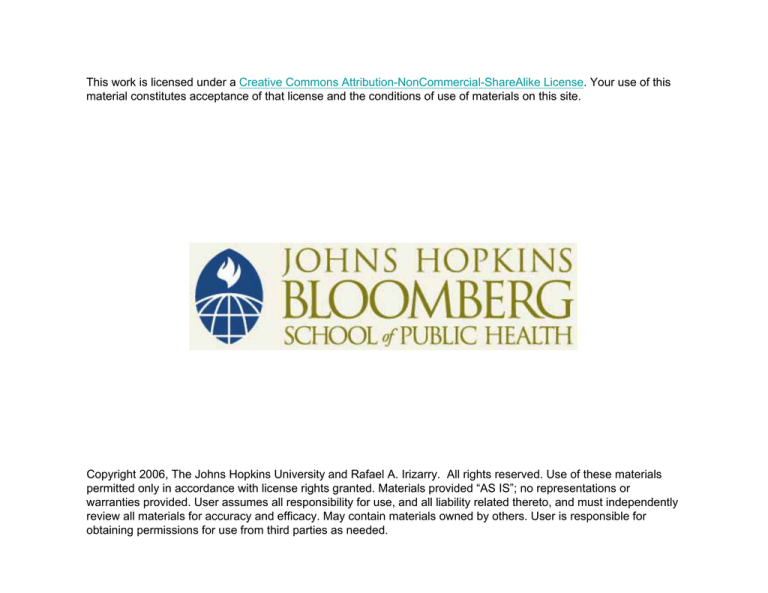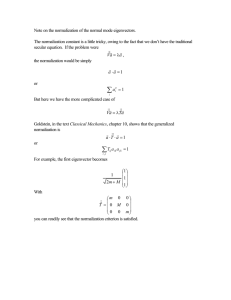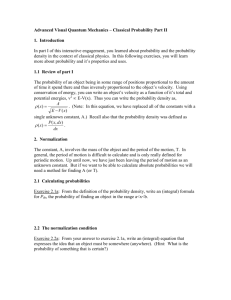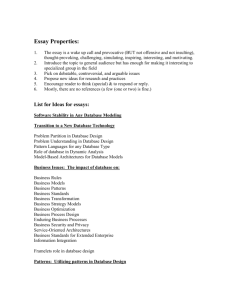
This work is licensed under a Creative Commons Attribution-NonCommercial-ShareAlike License. Your use of this
material constitutes acceptance of that license and the conditions of use of materials on this site.
Copyright 2006, The Johns Hopkins University and Rafael A. Irizarry. All rights reserved. Use of these materials
permitted only in accordance with license rights granted. Materials provided “AS IS”; no representations or
warranties provided. User assumes all responsibility for use, and all liability related thereto, and must independently
review all materials for accuracy and efficacy. May contain materials owned by others. User is responsible for
obtaining permissions for use from third parties as needed.
BIOINFORMATICS AND COMPUTATIONAL
BIOLOGY SOLUTIONS USING R AND
BIOCONDUCTOR
Biostatistics 140.688
Rafael A. Irizarry
Normalization
• Normalization is needed to ensure that differences
in intensities are indeed due to differential
expression, and not some printing, hybridization, or
scanning artifact.
• Normalization is necessary before any analysis
which involves within or between slides
comparisons of intensities, e.g., clustering, testing.
• Somewhat different approaches are used in twocolor and one-color technologies
Example of Replicate Data
Here different scanners were used
1
Example of Replicate Data
Most Common Problem
Intensity dependent effect: Different
background level most likely culprit
Scatter Plot
Demonstrates importance of MA plot
2
Two-color platforms
• Platforms that use printing robots are
prone to many systematic effects:
– Dye
– Print-tip
– Plates
– Print order
– Spatial
• Some examples follow
Print-tip Effect
spotting pin quality decline
after delivery of 5x105 spots
after delivery of 3x105 spots
H. Sueltmann DKFZ/MGA
3
Plate effect
Bad Plate Effect
Bad Plate Effect
4
Print Order Effect
Spatial Effect
Spatial Effects
R
Rb
R-Rb
color scale by rank
another
array:
print-tip
color
scale
~
log(G)
color
scale
~
rank(G)
spotted cDNA arrays, Stanford-type
5
0.6
10
0.8
20
1.0
30
1.2
1:nrhyb
40
1.4
50
1.6
1.8
60
Batches: array to array differences dij = madk(h ik -hjk)
1 2 3 4 5 6 7 8 910111213141516171823242526272829303132333435363738737475767778798081828384858687888990919293949596979899100
10
20
30
40
50
60
1:nrhyb
arrays i=1…63; roughly sorted by time
What can we do?
• Throw away the data and start again? Maybe.
• Statistics offers hope:
– Use control genes to adjust
– Assume most genes are not differentially
expressed
– Assume distribution of expression are the
same
Simplest Idea
•
Assume all arrays have the same median log expression or relative log
expression
•
Subtract median from each array
•
In two-color platforms, we typically correct the Ms. Median correction
forces the median log ratio to be 0
– Note: We assume there are as many over-expressed as underexpressed genes)
•
For Affymetrix arrays we usually add a constant that takes us back to
the original range.
– It is common to use the median of the medians
– Typically, we subtract in the log-scale
•
Usually this is not enough, e.g. it will not account for intensity
dependent bias
6
House Keeping Genes
I rarely find house keeping genes useful
More Elaborate Solutions
• Proposed solutions
– Force distributions (not just medians) to be the same:
• Amaratunga and Cabrera (2001)
• Bolstad et al. (2003)
– Use curve estimators, e.g. loess, to adjust for the effect:
• Li and Wong (2001) Note: they also use a rank invariant set
• Colantuoni et al (2002)
• Dudoit et al (2002)
– Use adjustments based on additive/multiplicative model:
• Rocke and Durbin (2003)
• Huber et al (2002)
• Cui et al (2003)
Quantile normalization
• All these non-linear methods perform similarly
• Quantiles is my favorite because its fast and
conceptually simple
• Basic idea:
–
–
–
–
order value in each array
take average across probes
Substitute probe intensity with average
Put in original order
7
Example of quantile normalization
Original
Ordered
Averaged
Re-ordered
2
4
4
2
3
4
3
3
3
3
5
3
5
4
14
3
4
8
5
5
5
8
5
8
4
6
8
3
4
8
5
5
5
6
8
5
3
5
8
4
5
9
6
6
6
5
6
5
3
3
9
5
6
14
8
8
8
5
3
6
Before Quantile Normalization
After Quantile Normalization
A worry is that it over corrects
8
Two-color Platforms
• Quantile normalization is popular with
high-density one channel arrays
• With two-color platforms we have many
effects to worry about and seems we
should take advantage of the paired
structure
ANOVA
• One of the first approaches was to fit
ANOVA models to log intensities with a
global effect for each Dye
• This does not correct for the non-linear
dependence on intensity
• Recent implementations subtract a
constant from the original scale to
remove the non-linear effect i
For references look at papers by Gary Churchill
Different Background
Above is MA for R=50+S, G=100+S
9
Correcting M approaches
• Most popular approach is to correct M directly
• We assume that we observer M + Bias and
that Bias depends on Intensity (A), print-tap,
plate, spatial location, etc…
• Idea: Estimate bias and remove it
• For continuous variables we assume the
dependence is smooth and use loess to
estimtate them
• The normalized M is M - estimated Bias
• Most versatile method
For details look for papers by Terry Speed and Gordon Smyth
Example: Intensity Effect
• The most common problem is intensity
dependent effects
– Probably due to different background
• Loess is used to estimate and remove
this effects
Loess
10
11
Print-tip Loess
12
Error model approaches
• Error model approaches describe the
need for normalization with an additive
background plus stochastic
multiplicative error model
• From this model an variance stabilizing
transformation is obtained
• Log ratios are no longer the measure of
differential expression
For details see papers by Wolfgang Huber and David Rocke
Following Slides Provided
by Wolfgang Huber
Error models
Describe the possible outcomes of a set of
measurements
Outcomes depend on:
-true value of the measured quantity
(abundances of specific molecules in biological sample)
-measurement apparatus
(cascade of biochemical reactions, optical detection
system with laser scanner or CCD camera)
13
The two component model
measured intensity = offset +
gain
× true abundance
yik = aik + bik xk
bik = bi bk exp(!ik )
aik = ai + !ik
bi per-sample
normalization factor
ai per-sample offset
e ik ~ N(0, bi2s12)
bk sequence-wise
probe efficiency
“additive noise”
hik ~ N(0,s22)
“multiplicative noise”
The two-component model
“multiplicative” noise
“additive” noise
raw scale
log scale
B. Durbin, D. Rocke, JCB 2001
Parameterization
y = a + " + b # x # (1 + !) two practically
y = a + " + b # x # e!
equivalent forms
(h<<1)
a systematic
background
e random
background
same for all probes
(per array x color)
per array x color
x print-tip group
iid in whole
experiment
iid per array
b systematic gain
factor
h random gain
fluctuations
per array x color
per array x color
x print-tip group
iid in whole
experiment
iid per array
14
Important issues for model fitting
Parameterization
variance vs bias
"Heteroskedasticity" (unequal variances)
⇒ weighted regression or variance stabilizing
transformation
Outliers
⇒ use a robust method
Algorithm
If likelihood is not quadratic, need non-linear
optimization. Local minima / concavity of
likelihood?
variance stabilizing transformations
Xu a family of random variables with
EXu=u, VarXu= v(u). Define
x
f (x ) =
1
!
v(u )
du
derivation: linear approximation
⇒ var f(Xu ) ≈ independent of u
10.0
9.5
f(x)
9.0
8.5
8.0
transformed scale
11.0
variance stabilizing transformations
0
20000
40000
60000
x
raw scale
15
variance stabilizing transformations
x
f (x ) =
!
1
v(u )
du
1.) constant variance (‘additive’)
v (u ) = s2
2.) constant CV (‘multiplicative’)
v (u ) ! u 2 " f ! log u
3.) offset
v (u ) ! (u + u 0 ) 2
"
f " u
!
f ! log(u + u0 )
4.) additive and multiplicative
v (u ) ! (u + u0 )2 + s 2 " f ! arsinh
u + u0
s
the “glog”
glog” transformation
- - - f(x) = log(x)
——— h s(x) = asinh(x/s)
(
arsinh( x ) = log x +
x2 + 1
)
lim (arsinh x # log x # log 2 ) = 0
x !"
P. Munson, 2001
D. Rocke & B. Durbin,
ISMB 2002
W. Huber et al., ISMB
2002
glog
raw scale
di
ffe
re
nc
log
lo
g
-r
e
at
io
glog
ge
n
lo er
g- al
ra ize
tio d
variance:
constant part
proportional part
16
the transformed model
arsinh
Yki " asi
= µk + !ki
bsi
!ki : N(0, c2 )
i: arrays
k: probes
s: probe strata (e.g. print-tip, region)
profile log-likelihood
pll (a, b) = sup ll (a, b, c, µ)
c ,µ
Here:
6
8
Least trimmed sum of squares regression
4
n/2
2
" ( y(i) ! f(x(i) ) )
2
i=1
0
y
minimize
0
2
4
6
8
P. Rousseeuw, 1980s
x
- least sum of squares
- least trimmed sum of squares
17
log
“usual” log-ratio
'glog'
(generalized
log-ratio)
log
x1
x2
x1 +
x12 + c12
x2 +
x22 + c22
c1, c2 are experiment specific parameters
(~level of background noise)
Estimated log-fold-change
Variance Bias Trade-Off
log
glog
Signal intensity
Variance-bias trade-off and shrinkage estimators
Shrinkage estimators:
pay a small price in bias for a large decrease of variance,
so overall the mean-squared-error (MSE) is reduced.
Particularly useful if you have few replicates.
Generalized log-ratio:
= a shrinkage estimator for fold change
There are many possible choices, we chose “variancestabilization”:
+ interpretable even in cases where genes are off in some
conditions
+ can subsequently use standard statistical methods
(hypothesis testing, ANOVA, clustering, classification…)
without the worries about low-level variability that are often
warranted on the log-scale
18
“Single color normalization”
normalization”
n red-green arrays (R1, G1, R2, G2,… R n, Gn)
within/between slides
for (i=1:n)
calculate Mi= log(Ri/Gi), Ai= ½ log(Ri*Gi)
normalize Mi vs A i
normalize M1…Mn
all at once
normalize the matrix of (R, G)
then calculate log-ratios or any other
contrast you like
Back to you Rafa!
Rafa!
Concluding Remarks
• Notice Normalization and background
correction are related
• Current procedures are based on
assumptions
• Many new problems clearly violate
these assumptions
• We will discuss this problem in another
lecture
19







